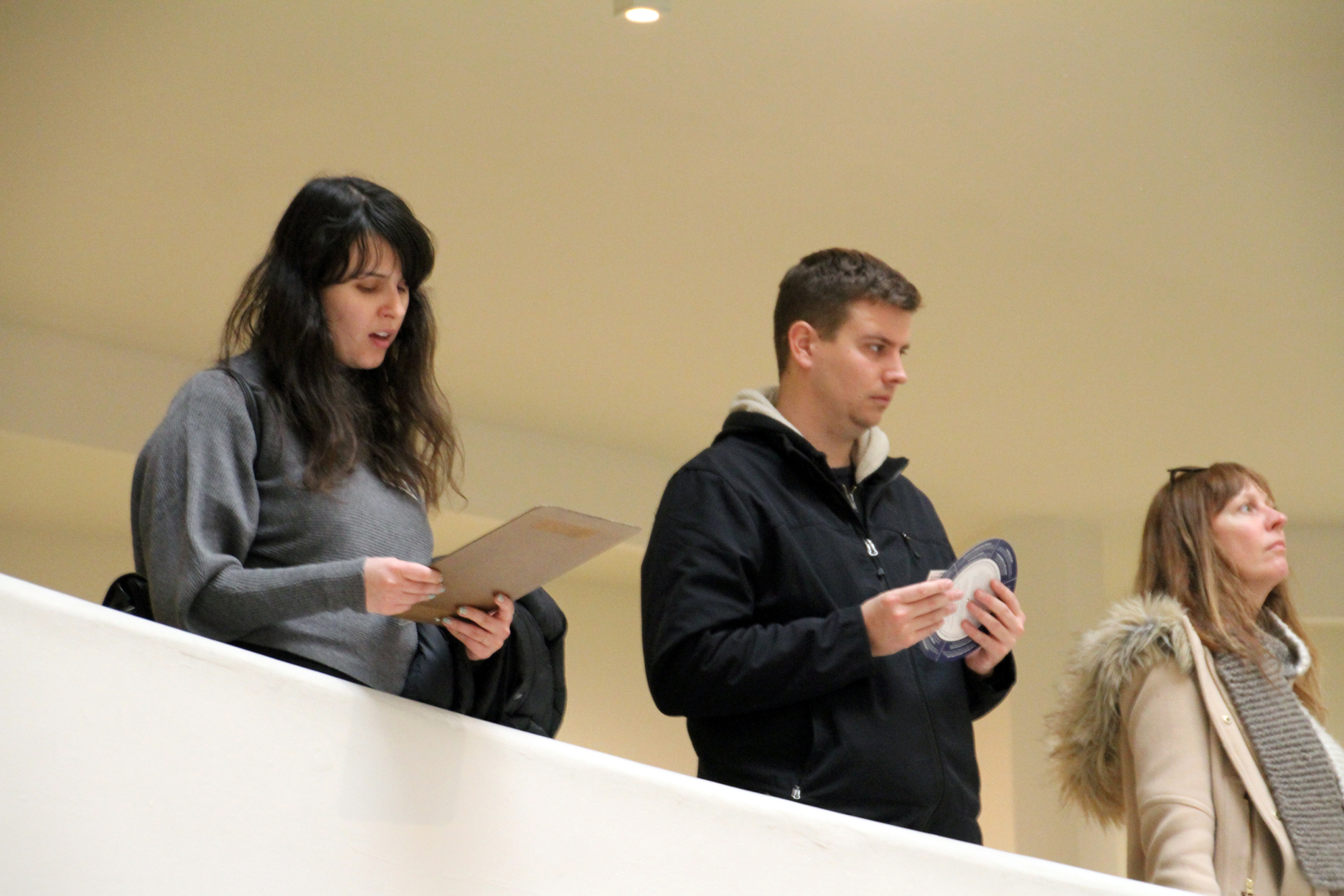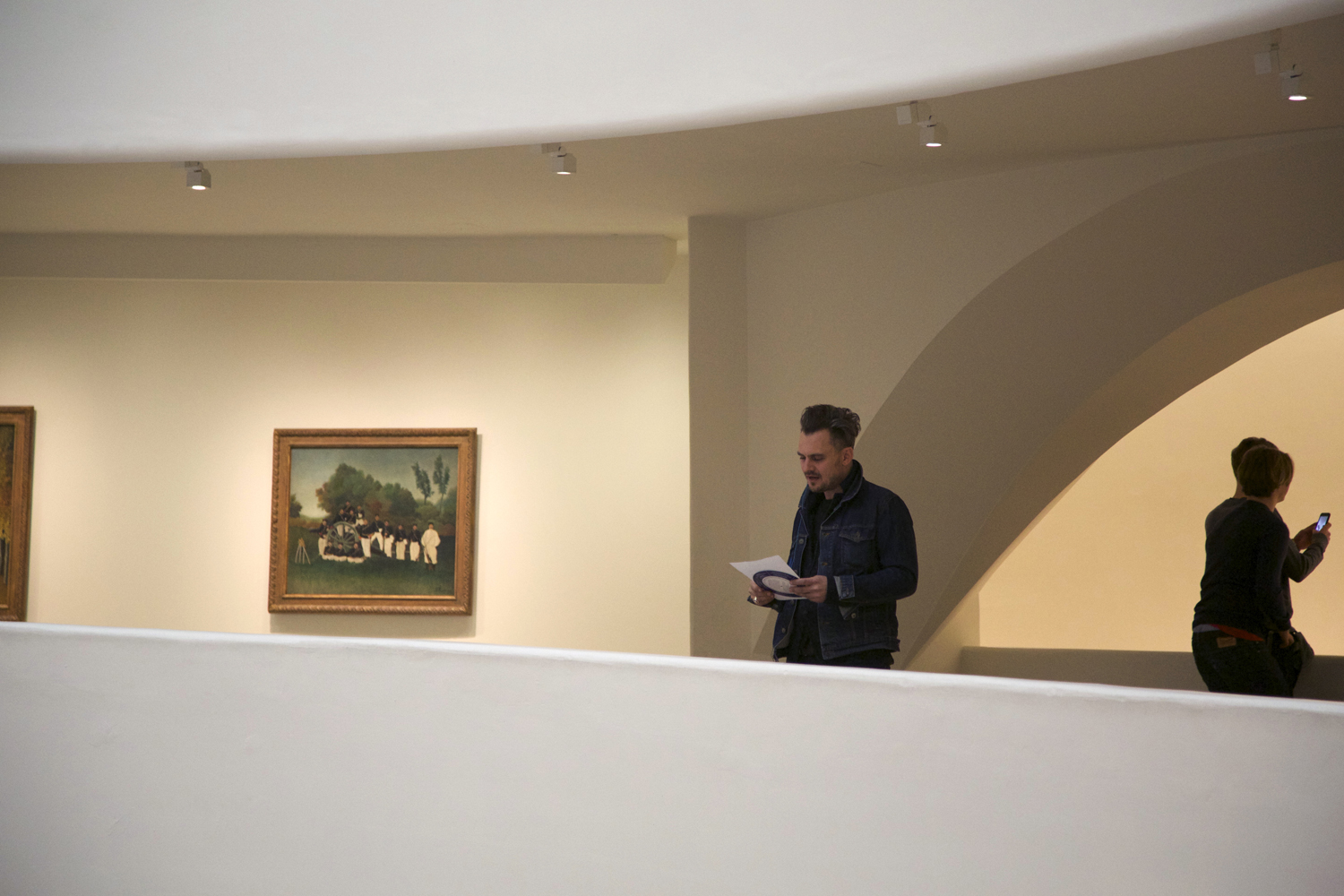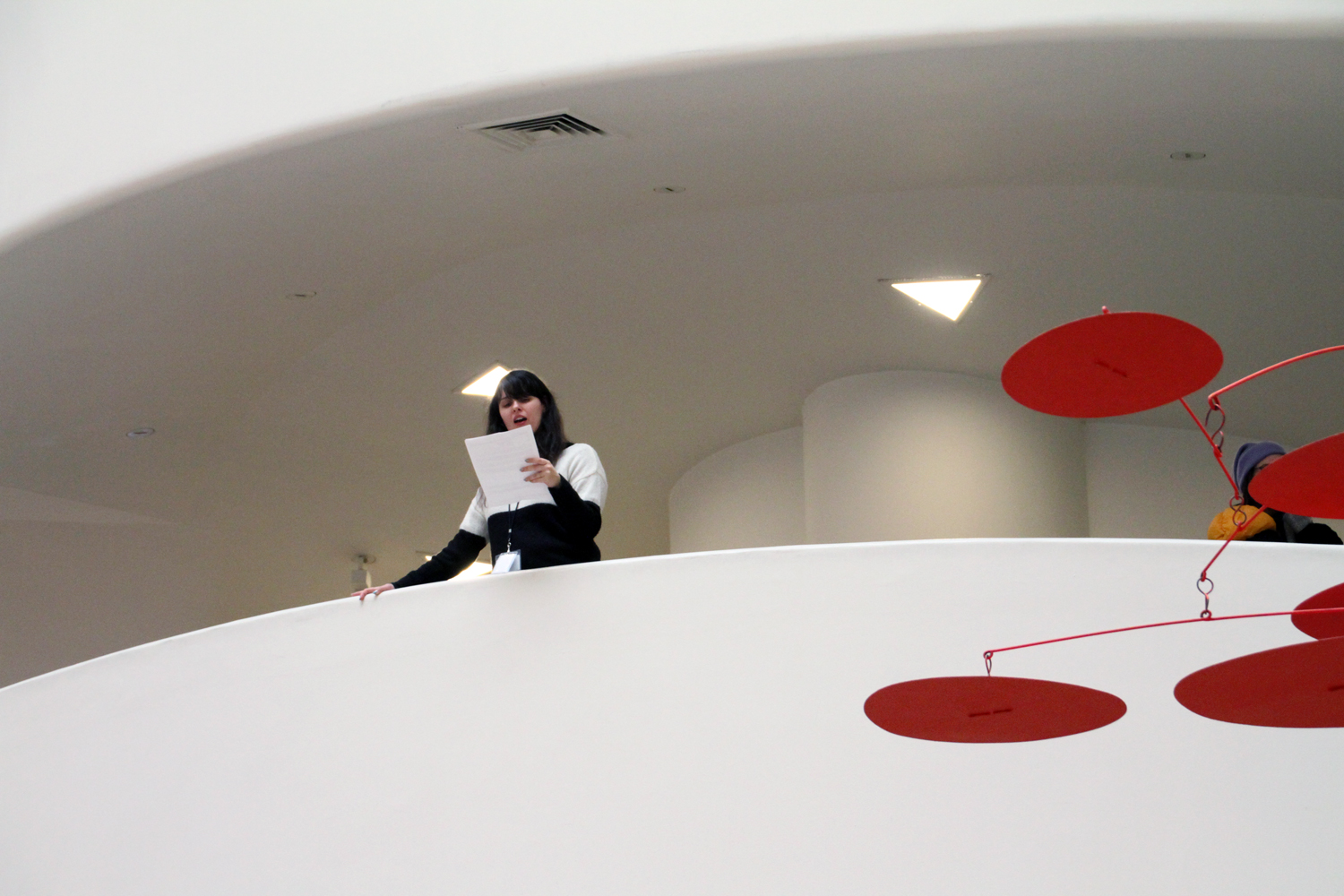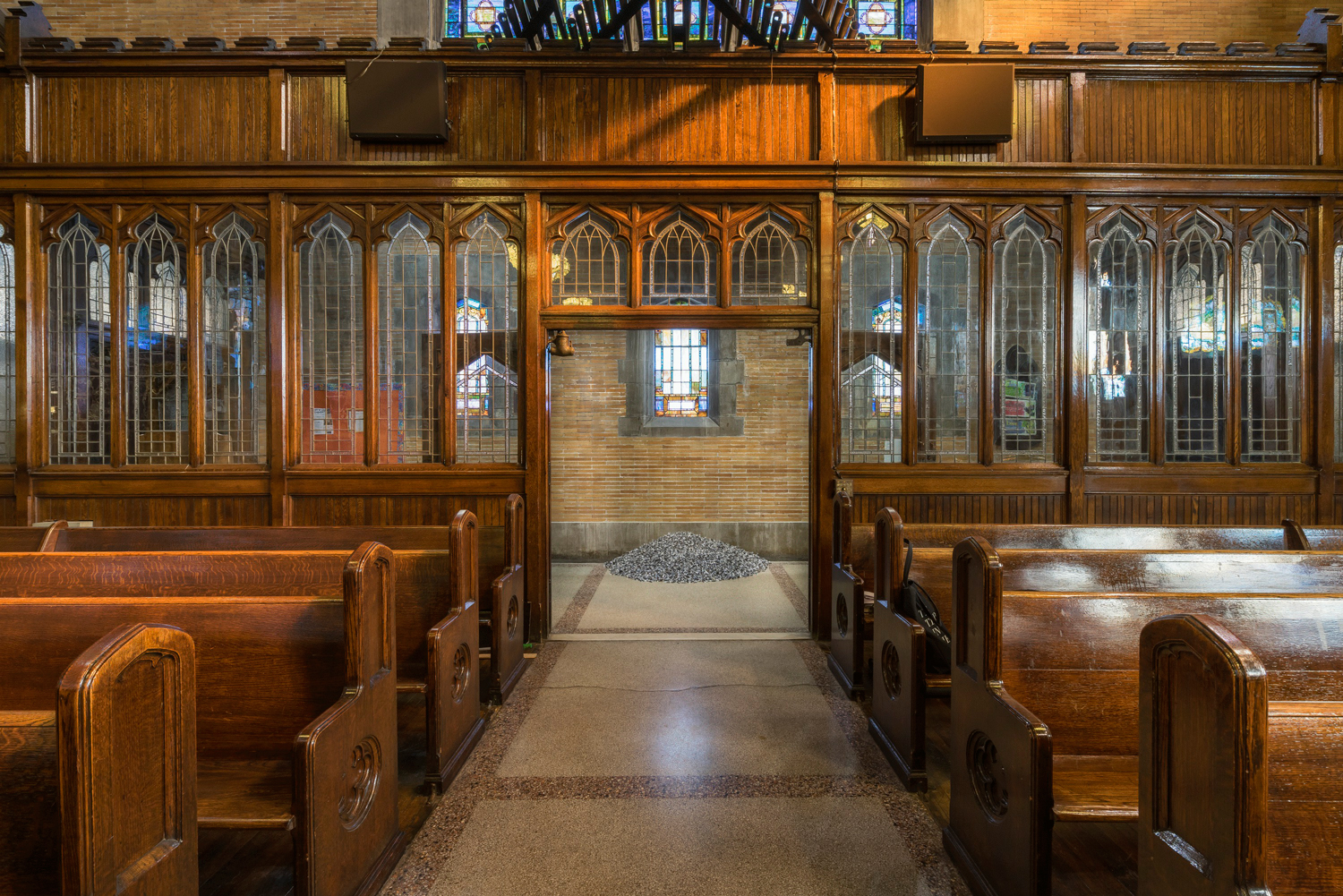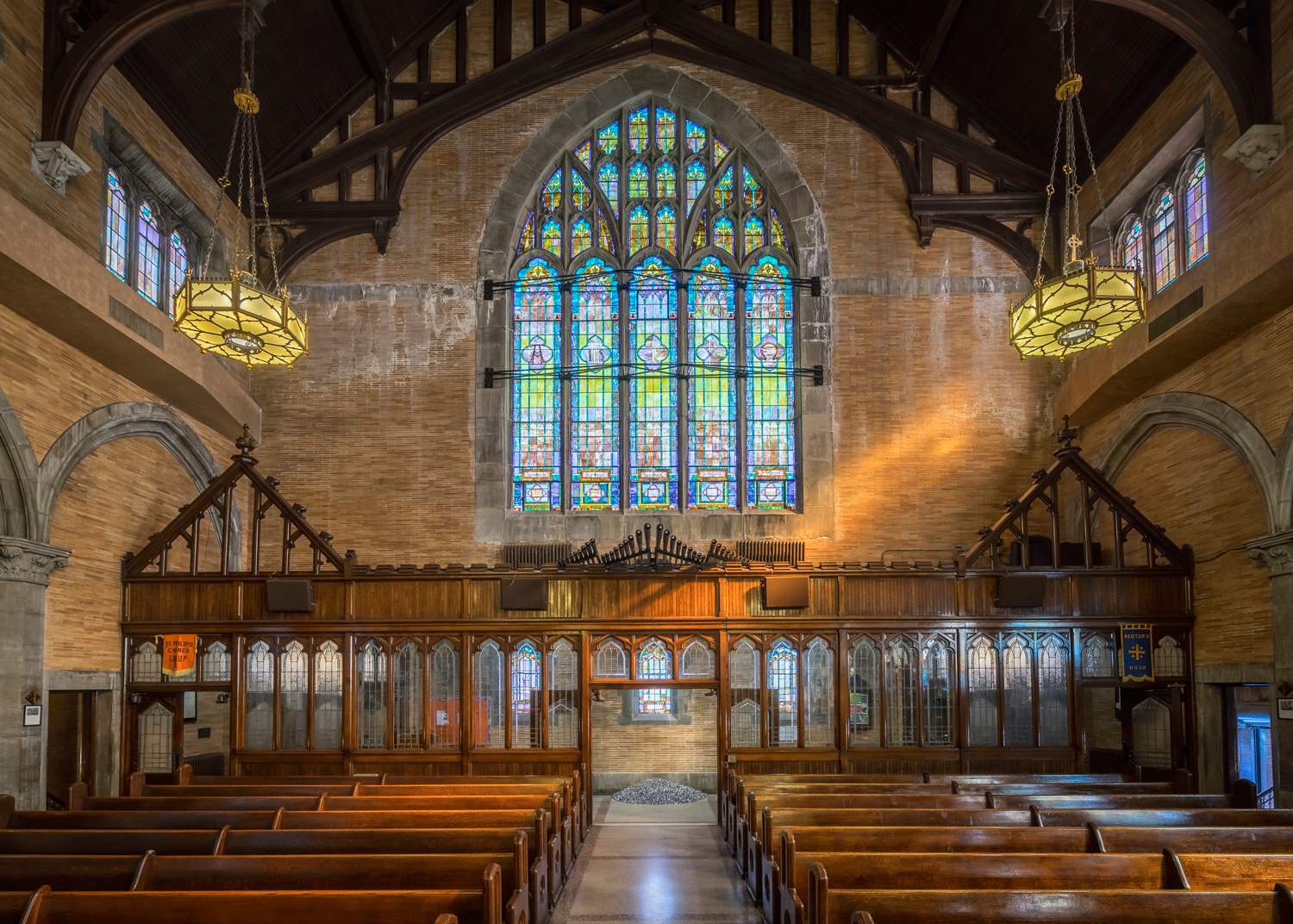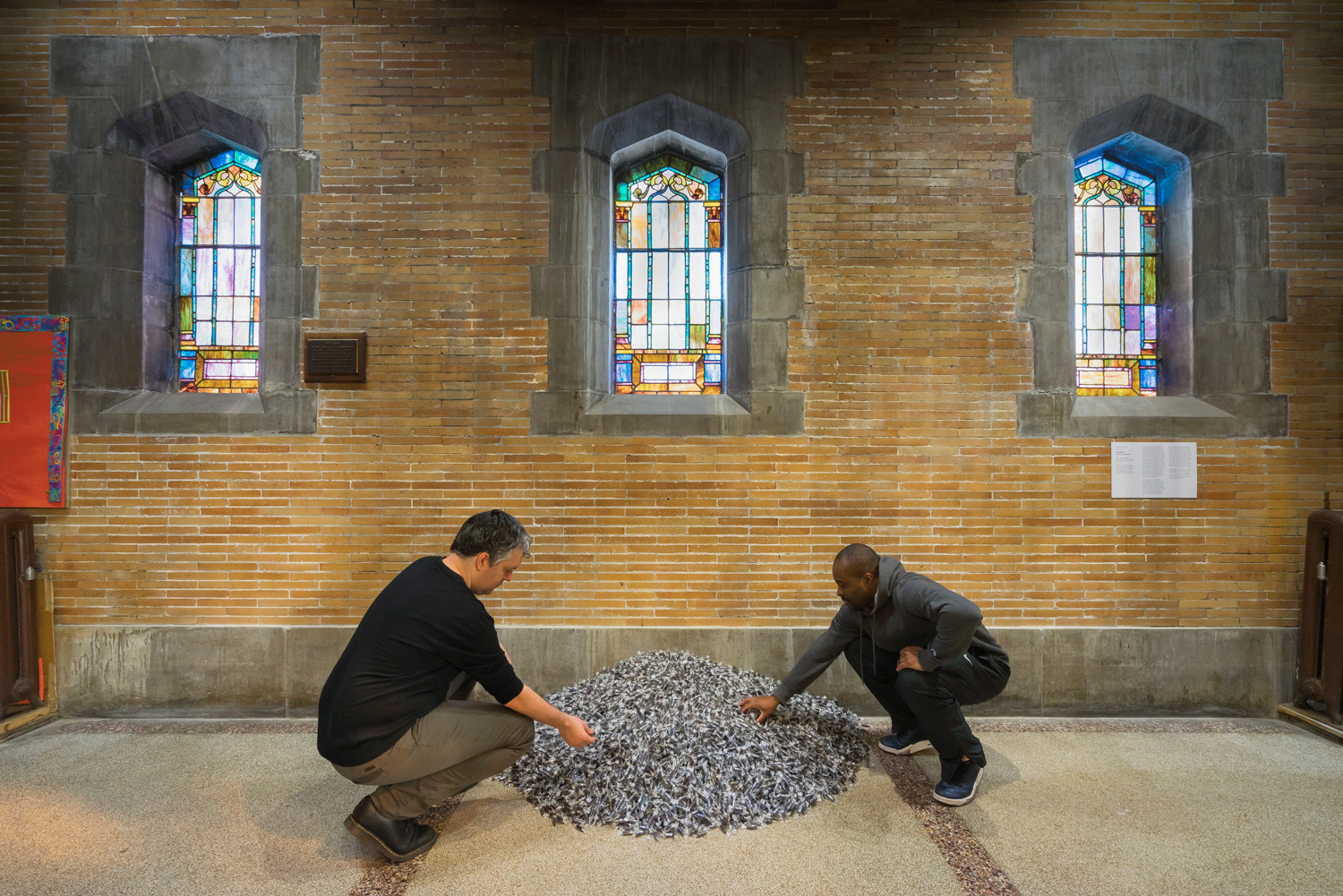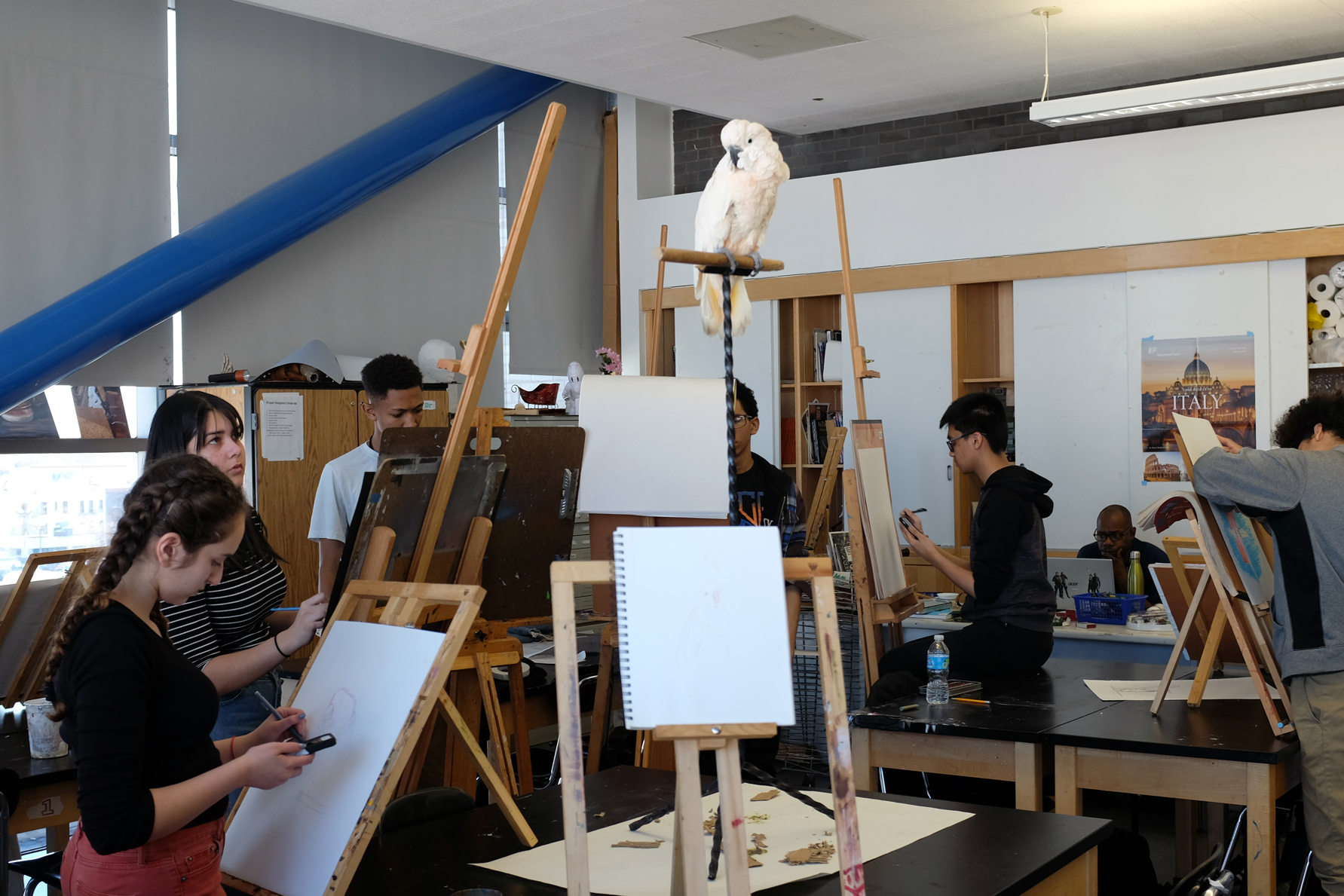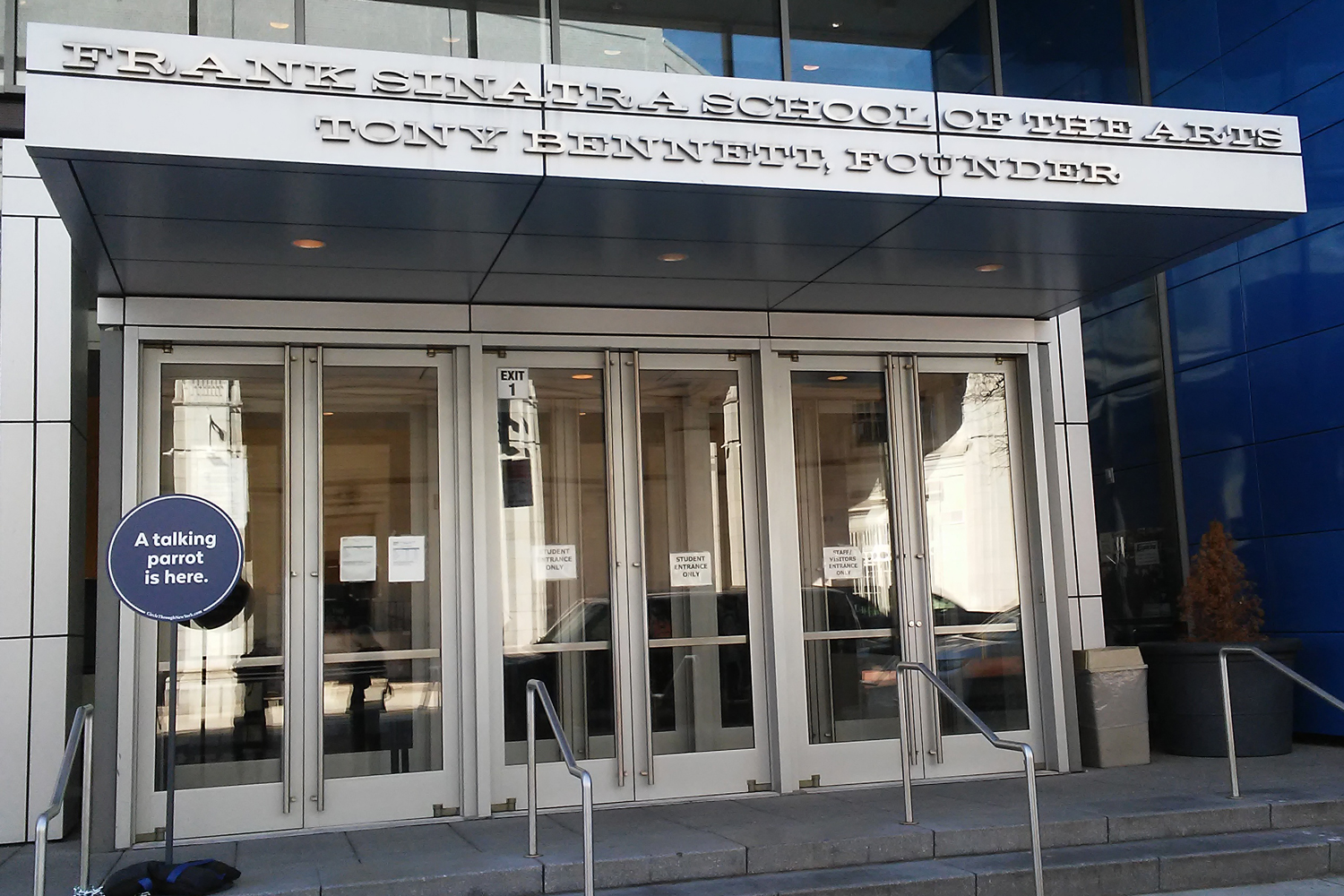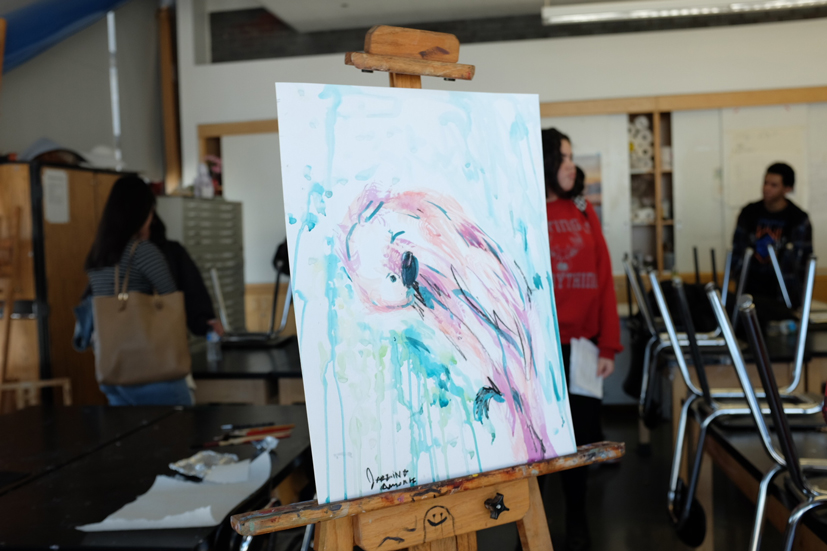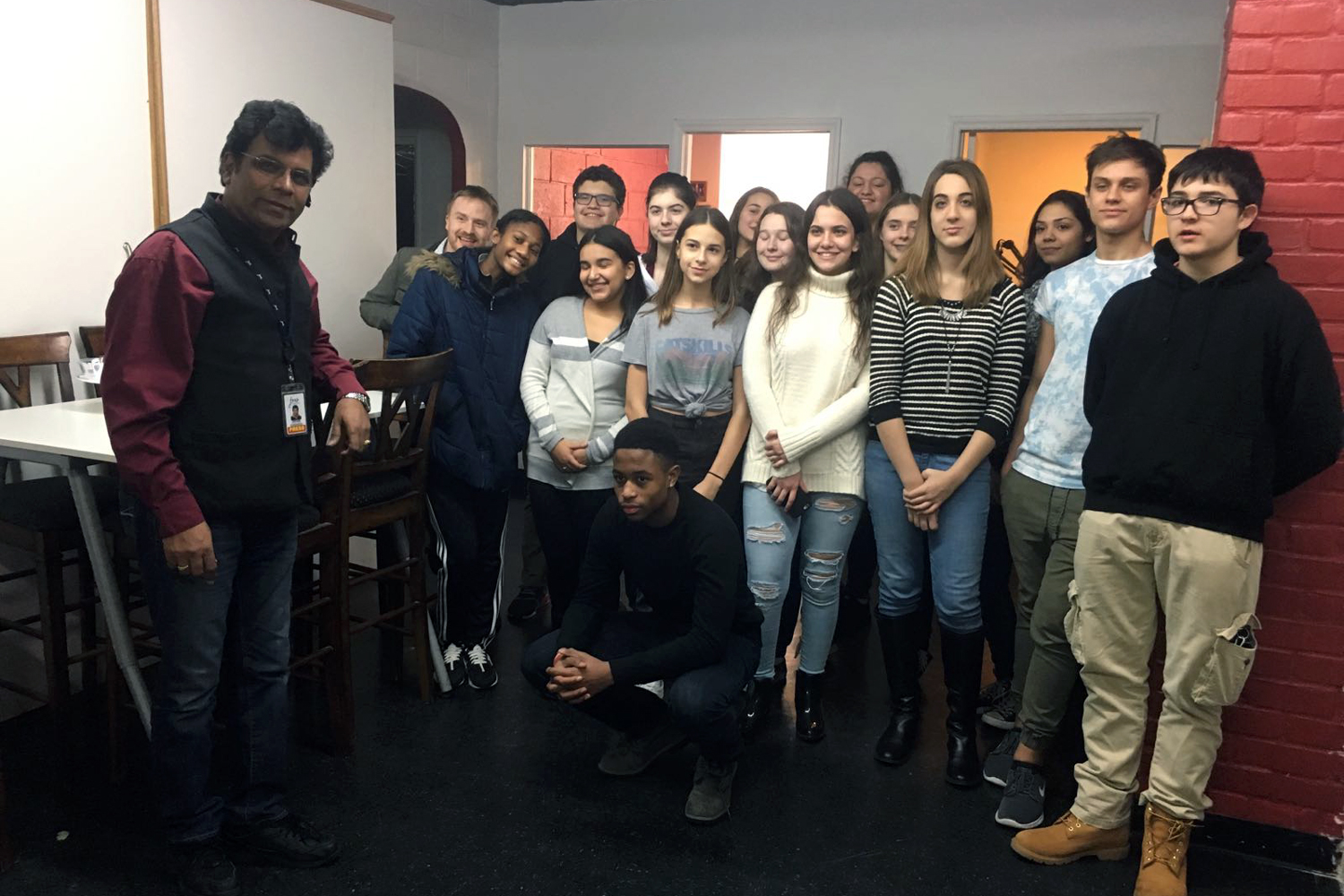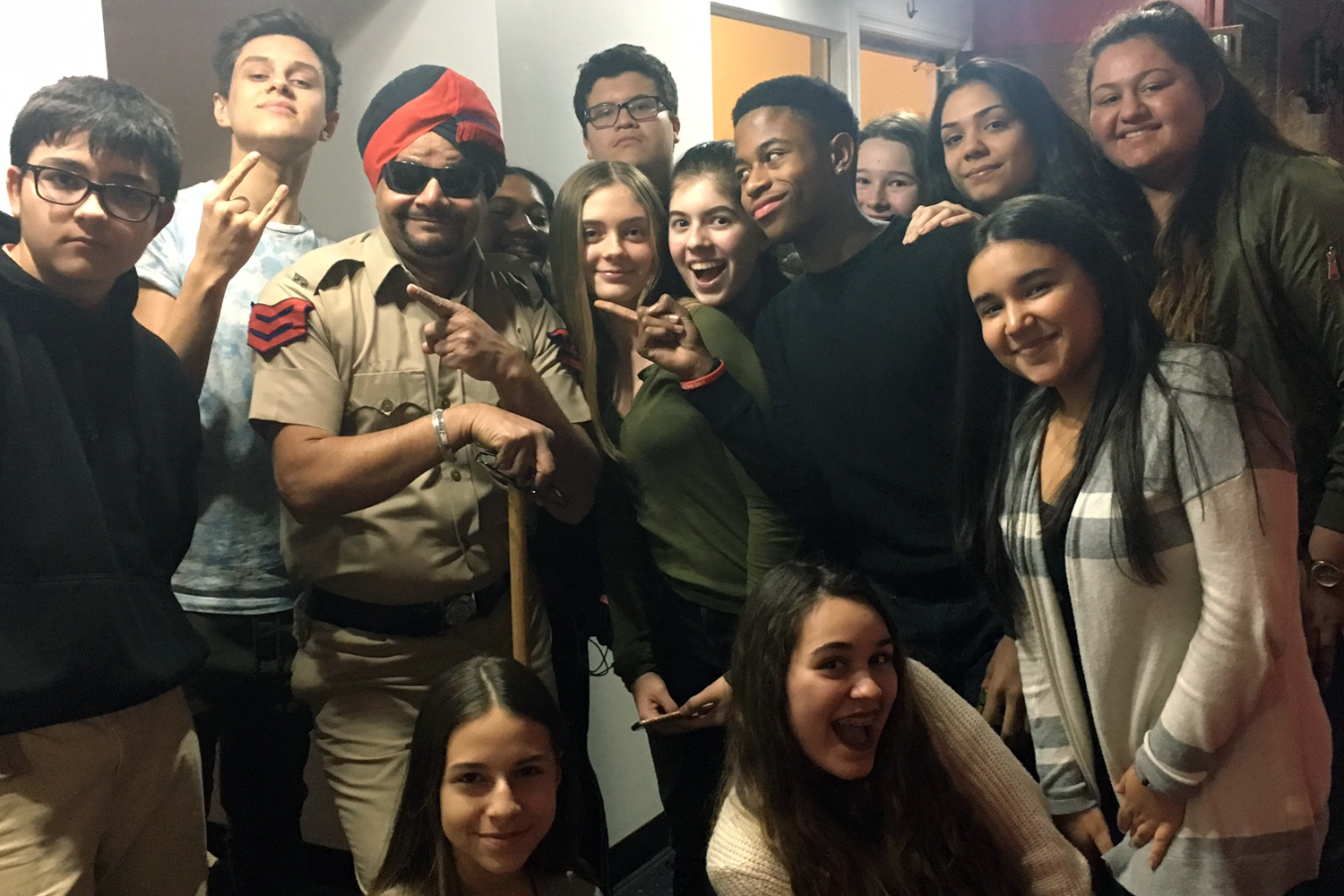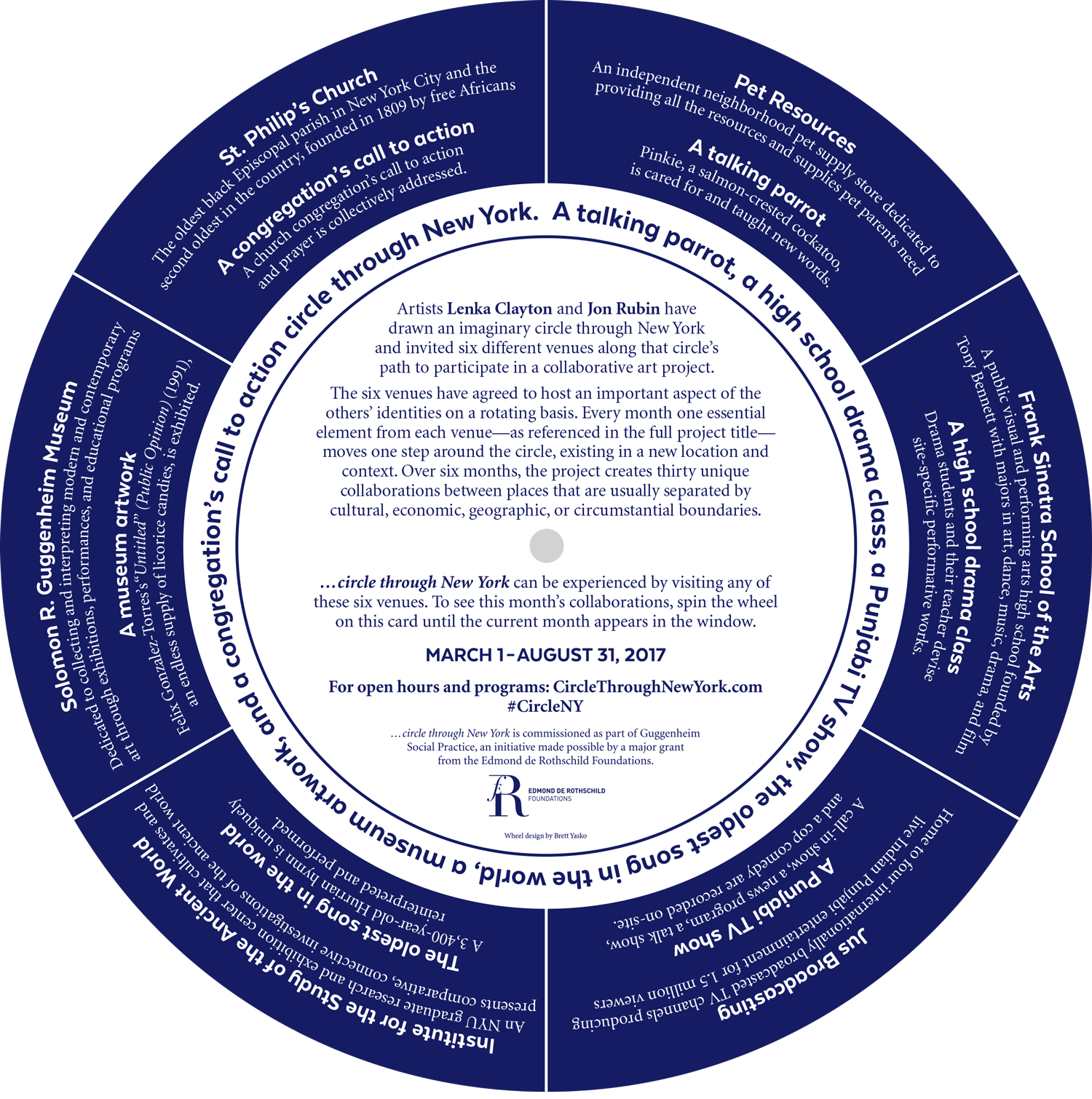Documentation: Giacomo Francia
Felix Gonzalez-Torres sculpture "Untitled" (Public Opinion) on view at St. Philip's Church.
In March, a museum artwork, “Untitled” (Public Opinion), 1991 by Felix Gonzales Torres, is be on view at St. Phillip's Church. The artwork, which is part of the permanent collection of the Solomon R. Guggenheim Museum, consists of a large quantity of individually wrapped licorice candies, which are poured directly on the floor, usually in a pile or flat rectangle, and available for viewers to take and eat. As this artwork travels around the circle, it is being installed by a team of museum professionals in response to the architecture of each site. This is the first time it has been exhibited outside of the context of a museum or gallery. Visit the church to meet members of the congregation and vestry and to view the artwork.
View the daily calendar to see dates and times you can visit the artwork.
Documentation: Giacomo Francia
Guggenheim Museum Staff Sing the Oldest Song in the World
The Guggenheim Museum has shifted their presentation of the oldest song in the world from quiet humming in the galleries to singing in the ramp around the central rotunda. Performances are daily at noon and 2pm. The public are also invited to join and can learn the song here (the melody can be sung without the lyrics). Sheet music is also provided in the museum's Aye Simon Reading Room.
Joan Borrell Sings the Oldest Song in the World at St. Philip's Church
On Autumn of 2015, while I was studying Architecture in Barcelona, Dr. Pedro Azara, a professor of mine with whom I had been lucky to work on several projects, was curating an exhibition with Dr. Jennifer Y. Chi at the Institute for the Study of the Ancient World, in New York. It was called From Ancient to Modern: Archaeology and Aesthetics. Jennifer and Pedro came up with the idea of reinterpreting “the oldest song in the world” to then put it on display in the exhibition. Pedro knew that I was a singer so they offered me the opportunity to sing it. It was called “A Hurrian cult song from ancient Ugarit” dating from 1400 BC. I have always been very interested in history and being able to mix it with my passion, music, was rather unusual. I immediately said “yes”. How could anyone refuse it?
I read all that I could find about the song and about music in ancient Mesopotamia, I talked to my singing teacher about it and tried different approaches to it. I finally decided to do an objective, and neutral interpretation of it and I recorded it in my studio.
Later, I was invited to NY by the ISAW, to perform the song live the day of the exhibition inauguration. By that time, I had read more about the song, I had sung it many more times and put more thought in it. That day I sang a different interpretation, a more personal one.
After a year, Jennifer Y. Chi contacted me: a couple of artists, Lenka Clayton and Jon Rubin, were interested in the song and they wanted it to be part of a project called . . . circle through New York.
--Joan Borell
Joan Borrell was born in Barcelona, Spain. Music has always been a very important part of his life.
He was classically trained in violin (from ages 3 to 12) and viola (from ages 13 to 16) as well as in music theory and composition. He as studied classical and modern singing since I was 17 years old. He regularly plays in a pop band and owns a recording studio in Barcelona.
Joan is a member of the international archaeological team from the Sorbonne University in Qasr Shamamok, Erbil (Iraq) since 2013. I performed and recorded the ancient Hurrian song “Hymn to Nikkal” to be displayed in the exhibition “Archaeology and Aesthetics” at the ISAW (2015). I also performed the Hymn live on the inauguration day of the exhibition. He volunteers in an orphanage in Kathmandu, Nepal, since December 2015, training children to sing and doing architectural rehabilitation work on the orphanage building.
Documentation: Giacomo Francia
This Sunday at 1:30pm: A Conversation on the Work of Felix Gonzalez-Torres
This Sunday at 1:30pm, St. Philip's vestry member Tod Roulette joins Nat Trotman, Curator of Performance and Media and the Guggenheim Museum, for an in-depth conversation about the work of artist Felix Gonzalez-Torres, whose 1991 sculpture "Untitled" (Public Opinion) is currently on view at St. Philip's Church.
St. Philip's Church, 204 West 134th Street, New York, NY, 10030
The Talking Parrot's First Day in the Frank Sinatra School of the Arts Drawing Class
Pinkie, the talking parrot, from Pet Resources in the South Bronx, is spending the month of March integrating throughout the Frank Sinatra High School of the Arts in Astoria, Queens. This week she is the subject of a life drawing class.
Documentation: Giacomo Francia and Aubrey Mike
Jus Broadcasting Airs Episode Shot with the High School Drama Class
Bikker Badshah with members of the High School Drama class
The congregation's call to action is taken up by Pet Resources
Pet Resources is taking up the congregation's call to action from St. Philip's Church in Harlem by informing their local community in the South Bronx about their rights if stopped or arrested by the police or immigration officials. Visit the store to get information and talk with staff, and participate in public discussions each Sunday afternoon with the pet store staff, customers, community members and invited special guests.
Pictured above: Pet Shop bird specialist, Aubrey Mike, broadcasting on the street and interacting with customers about their legal rights if stopped by the police.
Documentation: Giacomo Francia
The high school drama class visit JUS Broadcasting Punjabi TV station
The high school drama class making one of many research visits to JUS Broadcasting, their first stop on . . . circle through New York. They appeared on Bikkar, a corrupt-cop comedy show and are preparing a scripted segment based on their research that will be shot and broadcast film later in March.
The High School Drama Class Starts their Research by Visiting Several Partner Sites
A Museum Artwork is Installed at St. Philip's Church
A Museum Artwork, "Untitled" (Public Opinion) by Felix Gonzales Torres, is installed at St. Philip's Church throughout March. Visit the church to meet members of the congregation and vestry and to view the artwork.
“Untitled” (Public Opinion) is a 1991 work by Felix Gonzalez-Torres consisting of a large quantity—ideally 700 pounds—of individually wrapped licorice candies, which are poured directly on the floor, usually in a pile or flat rectangle, and available for viewers to take and eat. As this artwork travels around the circle, it will be installed by a team of museum professionals in response to the architecture of each site. This is the first time it has been exhibited outside of the context of a museum or gallery.
Photo's by Kristopher McKay, © Guggenheim Museum
Joan Borrell Interview on the World’s Oldest Song by Jus Punjabi TV
French Archaeological Mission to Ras Shamra-Ugarit, photographs of Françoise Ernst-Pradal.
Dossier on the Hurrian Hymn
What is sometimes called “The Hurrian Hymn” is the earliest known example of music notation, dating to around the 13th century BCE. The hymn is written on a clay tablet (about the size of a smart phone), in cuneiform script. Cuneiform is the earliest known form of writing, which used a stylus (usually of reed) to make fine incisions on wet clay. Cuneiform was a complex writing system, used to write several different languages (as our alphabet is also used to write different languages). This tablet is a good example of this, as it includes the words of the song (lyrics) in the Hurrian language, and the music instructions (or “notation”) in Akkadian. Akkadian is an early Semitic language, belonging to the same family of languages as Arabic and Hebrew. Hurrian, on the other hand, is not related to any contemporary language, and it is poorly understood.
The tablet was found at the site of ancient Ugarit (contemporary Ras Shamra), 1km from the Syrian coast. There are several other examples of tablets with music notation from this site, but one well preserved example (although even this tablet is damaged). The tablet was discovered during French excavations of the 1950s, in the archives of the royal palace, together with many other texts of various types, such as letters and administrative documents. It is now in the National Museum of Damascus, Syria.
Ugarit was a city known for being a cosmopolitan centre during the late Bronze Age (14th and 13th centuries). This was due to its being a gateway for trade on the Mediterranean coast, as well as the fact that it was constantly being fought over by the great powers to its east (Mittanni, contemporary northern Syria), south (Egypt) and north (Hatti, contemporary Turkey). The cosmopolitan character of Ugarit in this period, is confirmed by the multilingual nature of texts found there, such as the Hurrian Hymn that uses both the Hurrian language for the lyrics, and the Akkadian language for music notation.
The upper part of the tablet obverse includes a hymn written in Hurrian. The text of this hymn is difficult to translate. However, the theme is clearly the promotion of fertility. It is addressed to the moon goddess, Nikkal. It refers to the making of offerings and libations (sesame oil) to the deity, and the placing of a ritual object (of lead) at the foot of the divine statue. The lower part of the tablet (below the double line) includes musical instructions, written in Akkadian.
The above text is excerpted from a longer dossier that Sam Mirelman, graduate student at the Institute for the Study of the Ancient World, wrote for the project partners. Download Sam Mirelman's complete information sheet on the Hurrian Hymn here. Download sheet music interpretation of the Hymn here.
St Philips Church compose their Call to Action
A Call to Action against Social Injustice
We are a band of faithful Christians who organized in 1809 to worship in a non-segregated church and to educate, socialize, and recognize the African-American contribution in all of society. There was--and persists today--fear, ignorance, greed, and wilful discrimination that hurts many in our midst. We fervently ask that all who hear our story take action against these injustices, including self-examination of your own participation in discrimination and injustice. Always be just as ready to listen as you are emboldened to speak out for or against others.
By "many in our midst" we are referring to a broad swath of people affected by current events, which include, among others:
- Muslims (i.e. the "Immigration" Muslim ban & attack on Mosques around the nation)
- The poor (i.e. repeal of the Affordable Care Act, by and large a program used by those of lesser means)
- The LGBTQ community ("religious freedom" bills in several states allowing organizations to refuse service to LGBTQ persons on the grounds of religious beliefs)
- Jews (the rise of swastikas on Jewish buildings & bomb threats on buildings)
- Latinos (the rise of hate speech toward Latinos, telling them to "go home"; new ICE raids on Latinos for deportation)
- Immigrants (the alt-right groups espousing "whiteness" as the litmus test for being American, some even using the Nazi salute at their gatherings)
- African-Americans (the continuing saga of deadly encounters with police and/or constant instances of racial profiling such as the Flint, MI water crisis)
- Native Americans (the approval to continue building oil pipelines over sacred lands and at the risk of contamination of water)
This call to action will rotate around the circle, being interpreted by each venue in turn according to their own communities and capacities.
Introducing Project Partners - Frank Sinatra School of the Arts
Frank Sinatra School of the Arts offers the opportunity for all students to achieve their fullest academic and artistic potential. This is accomplished through a rigorous educational program, which includes a challenging academic program, pre-conservatory studio work, experiences with cultural institutions, and intensive participation in community service. The school was founded by world-renowned entertainer, Tony Bennett, and his wife Susan Benedetto, to honor Tony's late friend and colleague, Frank Sinatra. At Mr. Bennett's encouragement, students are offered the opportunity to gain real world experience in the arts through internships and apprenticeships. Graduates will be prepared for both the finest conservatories and the best universities in the country. Our graduation rate has been one of the highest in the city and our graduates have gone on to rigorous, highly selective conservatories, art programs and competitive colleges and universities. Previous classes have been awarded several millions of dollars in scholarships. All of the people associated with the school - administrators, teachers, artists and performers - are consonant in their belief that students should be committed and dedicated to their art form, not fame and celebrity. Students should be prepared to work hard and long in their chosen field, learn to appreciate the art itself, and, finally, to see their hard work as its own reward. From vision to course development to day-to-day teaching, the school is designed to reinforce its dedication to the arts.
Introducing Project Partner - St. Philips Church, Harlem
Celebrating 208 years in 2017, St. Philip’s Church was founded in 1809 and is the second oldest Episcopal Church in the United States to be organized and led by African Americans. A hallmark throughout its history has been its continuous role in the struggle for justice and well-being. From inception, St. Philip’s, through its strong clergy and lay members, have played a critically important role as abolitionists, anti-lynching and anti-Jim Crow demonstrators and activists, facilitators of mental health care services to black and poor people (when there was none available), and as community housing developers. The Legacy extends through the current time with the church’s work around issues of justice for the formerly incarcerated, among other areas. It should also be noted that St. Philip’s Church served as the spiritual home for the former Supreme Court Justice Thurgood Marshall during the time that he worked on and won several landmark cases as head of the NAACP Legal Defense Fund.
Designated a landmark building in 1993, the church’s current structure was designed and built by the African American architecture firm of Tandy & Foster in 1911. Vertner Tandy, the first African American licensed architect in New York state, was also a member of St. Philip’s Church. Over the years the beautiful architecture and wonderful acoustics of the church have made it an ideal home for great theatre productions, musical performances, and art exhibits. Through these various mediums St. Philip’s has sought to minister holistically to mind, body, and spirit of both individuals and the wider community.
Read MoreGuggenheim Curator Nat Trotman Draws Out Plan for Installing Artwork at Each Site
Research Map
In the year leading up to the launch of ...circle through New York the artists Lenka Clayton and Jon Rubin walked, cycled and drove the imaginary circle through New York, visiting every public location that happened to fall on the line of the circle.
Spinning Wheel Drafts
Here is an early draft of the spinning wheel. This wheel will be given out for free at each of the six locations around the circle. It acts as an introduction to the project, and a map so that viewers can follow each circulating thing around the circle over the course of the project.
Spinning wheel designed by Brett Yasko
Design for Outdoor Signs
Shop drawings of the signs that will stand outside each venue during the project. Currently in production.





